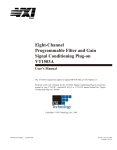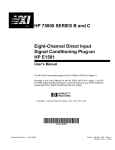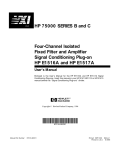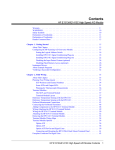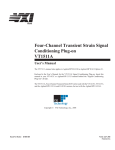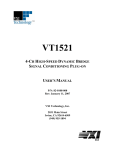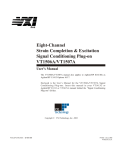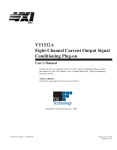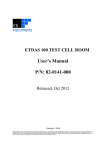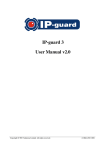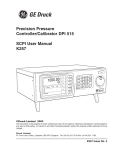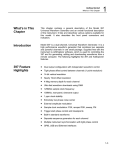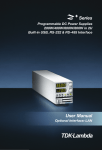Download Eight-Channel Divide by 16 Fixed Attenuator
Transcript
bus Eight-Channel Divide by 16 Fixed Attenuator-Low Pass Filter Signal Conditioning Plug-on VT1513A User’s Manual Enclosed is the User’s Manual for the VT1513A Signal Conditioning Plug-on. Insert this manual in your VT1413C or Agilent/HP E1313 manual behind the “Signal Conditioning Plug-ons” divider. Copyright © VXI Technology, 2003 Manual Part Number: 82-0087-000 Printed: July 9, 20032 Printed in U.S.A. VT1513A Eight-Channel Divide by 16 Attenuator Signal Conditioning Plug-on Introduction The VT1513A is a Signal Conditioning Plug-on that provides eight divide by 16 attenuators and fixed low-pass filters with a 3 dB cutoff frequency of 7 Hz. Also provided is input over-voltage protection. The VT1513A allows maximum input voltage of 60 VDC between High and Low, or from High or Low to Chassis. About this Manual This manual shows you how to control the Signal Conditioning Plug-on (SCP) using SCPI commands as well as Register-Based commands, and explains the capabilities of this SCP. Finally, it covers specifications for this SCP. The contents of this manual are: · · · · · · · Description . . . . . . . . . . . . . . . . . . . . . . . . . . . . . . . . . . . . . . . . . . . . . . . . Installation . . . . . . . . . . . . . . . . . . . . . . . . . . . . . . . . . . . . . . . . . . . . . . . . Identifying the Plug-on . . . . . . . . . . . . . . . . . . . . . . . . . . . . . . . . . . . . . . . Connecting To The Terminal Module . . . . . . . . . . . . . . . . . . . . . . . . . . . . Programming With SCPI Commands . . . . . . . . . . . . . . . . . . . . . . . . . . . . Programming With Register Commands . . . . . . . . . . . . . . . . . . . . . . . . . Specifications . . . . . . . . . . . . . . . . . . . . . . . . . . . . . . . . . . . . . . . . . . . . . . 1 2 2 3 5 8 9 Description Attenuator The VT1513A is a balanced high impedance input attenuator that provides both 1 differential mode and common mode gain of ( ). The input resistance is 1 MOhm 16 to chassis from either the high or low input. The resistor network used for the attenuator, provides accurate gains and moderate common mode rejection. The gains will be within 0.1% of each other and the common mode rejection will be approximately 60 dB. The input will not be a true differential input, in that the gain on the low side cannot be calibrated. Therefore the gain will be specified from high to low and the low input should be connected to Introduction VT1513A Divide by 16 Attenuator 1 the common mode input voltage. If the high input where grounded and a signal was applied to low, the gain could be in error by 0.1%. Noise Filter and The narrow bandwidth of approximately 7 Hz provides about 27.8 dB of Output Buffer attenuation for 60 Hz signals. The filters are balanced and have two real poles. A pair of buffers drive the signal through another broad band low-pass filter to the A/D multiplexer. Block Diagram Figure 1 Partial Block Diagram Installation Installation for this Plug-on is common to several others and is covered in Chapters 1 and 2 of your VT1413C or VT1415A manual. Identifying the Plug-on You’ll find the VXI Technology part number on the connector side of the SCP to the left of the serial number bar code. For the VT1513A, the part number is : VT1513A. 2 VT1513A Divide by 16 Attenuator Installation Connecting To The Terminal Module This section shows how to make connections to the Terminal Module. The SCP connections for the Terminal Modules are shown on the stick-on labels that came with the SCP. Use the appropriate label for the type of Terminal Module you have. Figure 2 VT1513A C-Size Terminal Module Connections Connecting To The Terminal Module VT1513A Divide by 16 Attenuator 3 Figure 3 VT1513A B-size Terminal Module Connections (Ch 00-31) Figure 4 VT1513A B-size Terminal Module Connections (Ch 32-63) 4 VT1513A Divide by 16 Attenuator Connecting To The Terminal Module Recommended Measurement Connections The following illustration shows the recommended method of wiring to the VT1513A. Figure 5 Wiring to the VT1513A Attenuator Note All guard connections for a particular SCP tie to a common point, therefore different common mode voltages should not be tied to this shared guard. Programming With SCPI Commands The SCPI commands shown here are covered in Chapters 3 and 5 of your VT1413C or Agilent/HP E1313 manual and Chapters 3 and 6 of your VT1415A manual. This section will relate those commands to the parameter values which are specific to this Plug-on. Range Selection The [SENSe:]Function:... commands include the range parameter. This parameter selects the A/D range for the measurement. Set this parameter based on the maximum input voltage you expect, divided by 16 (the attenuation factor). 1 While you have to keep in mind the channel gain ( ) when you set the range, the 16 DSP knows the gain and your range selection, and returns the actual input value, not the divided value. Example: Recommended Measurement Connections VT1513A Divide by 16 Attenuator 5 Maximum input value expected for channels 32 through 35 is 48 volts. 48 volts divided by 16 is 3 volts. You can use the 4 volt A/D range. SENS:FUNC:VOLT 4,(@132:135) meas volts on chs 32-35, 4 V range With input voltages of 15, 22, -40, and 55 volts DC, the reading values will be 1.5E+1, 2.2E+1, -4.0E+1, and 5.5E+1 respectively. Auto-Range If you wish to use auto-range (range parameter not sent or set to AUTO), you should limit the lowest A/D range used to the 1 volt range. The reason for this can be seen in the noise figures presented in the “DC Measurement Accuracy” specifications on page 10. The signal-to-noise ratio of the 1 and 4 volt ranges is much better than the 0.0625 and 0.25 volt ranges. The lower ranges’ increased resolution is offset by increased noise. To keep your module from selecting the 0.0625 and 0.25 volt ranges for VT1513A channels, send the command DIAG:FLOOR <range_floor>,(@<ch_list>). Example: To limit lowest range on VT1513A channels to the 1 volt range DIAG:FLOOR 1,(@132:140) all 8 channels in SCP position 4 The same noise limitation is true for manual selection of ranges. Checking the ID of the SCP To verify the SCP type(s) installed on the VT1413C and Agilent/HP E1313 use the SYSTem:CTYPe? (@<channel>) command. · The channel parameter specifies a single channel in the channel range covered by the SCP of interest. The first channel number for each of the eight SCP positions are; 0,8,16,24,32,40,48 and 56. The returned value is: HEWLETT-PACKARD,E1513A 8-Channel Fixed Attenuator-Filter SCP,0,0 To determine the type of SCP installed on channels 0 through 7 send SYST:CTYP? (@100) query SCP type @ ch 0 execute enter statement here Querying the Filter Cutoff Frequency While the Low Pass Filter SCP does not provide programmable cutoff frequency the filter frequency can be queried. The response to this query will always be 7. To q u e r y a n y ch a n n e l f o r its c u to f f f r e q u e n c y u s e th e INPut:FILTer[:LPASs]:FREQuency? (@<channel>) command. The INP:FILT:FREQ? command returns the numeric cutoff value currently set for the channel specified. · The channel parameter must specify a single channel. 6 VT1513A Divide by 16 Attenuator Programming With SCPI Commands To query the cutoff frequency of channel 6 send INP:FILT:FREQ? (@106) query channel 6 execute enter statement here Querying the Filter State While the Low Pass Filter SCP does not allow controlling whether the filters are enabled or disabled, this state can be queried. The response to this query will always be 1. To query any channel to determine if it is enabled or disabled use the INPut:FILTer[:LPASs][:STATe]? (@<channel>) command. The INP:FILT? command returns a 0 if the channel is OFF or a 1 if the channel is ON. · The channel parameter must specify a single channel. To query the filter state of channel 2 send INP:FILT? (@102) query channel 2 execute enter statement here Querying the Channel Gain While the Low Pass Filter SCP does not provide amplifiers, the channel gain can be 1 queried. The response to this query will always be 0.0625 (gain = ). To query any 16 channel to determine its gain setting use the INPut:GAIN? (@<channel>) command. The INP:GAIN? command returns the current gain value for the specified channel. · The channel parameter must specify a single channel. To query the gain setting of channel 8 send INP:GAIN? (@108) query channel 8 execute enter statement here Programming With SCPI Commands VT1513A Divide by 16 Attenuator 7 Register Based Programming The register-based commands shown here are covered in Appendix D of the VT1413C or Agilent/HP E1313 manual. You should read that section first to become familiar with accessing registers and executing Register-Based Commands. This section will relate those commands to the parameter values which are specific to this Plug-on. When Register Programming an SCP most communication is through the Signal Conditioning Bus. For that you will use the Register Commands: SCBWRITE <regaddr> <regvalue> and SCBREAD? <regaddr> VT1513A Register Map Read (returned value) SCP ID (707016) Write( <regvalue>) SCP Register Whole SCP Reg 0 <regaddr> Value 00ppp0000002 ppp=Plug-on ccc=SCP channel In addition you will access bits in the Card Control register to control Open Transducer Detection. Checking ID of SCP 8 VT1513A Divide by 16 Attenuator To query an SCP for its ID value, write the following value to Parameter Register 1: ( SCP number ) ´ 4016 Then write the opcode for SCBREAD? (080016) to the Command Register. The ID value will be written to the Query Response Register. Register Based Programming Specifications These specifications for the VT1513A reflect the combined performance of the VT1413C or Agilent/HP E1313 and the VT1513A Signal Conditioning Plug-on. These specifications are not to be added to those presented in the VT1413C User’s Manual. General Specifications ±1 V to ± 60 VDC Full Scale Measurement ranges Operating: ±60 VDC Maximum input voltage ±42 V peak (Normal mode plus common mode) Maximum common mode voltage Operating: ±60 VDC ±42 V Peak @ 7 Hz -3dB, @ 50 Hz > -24@ 60 Hz > -27 dB Normal mode rejection 0 - 60 Hz - 60 dB Common mode rejection 1 MOhm ±1% (each differential input to ground) Input impedance (Maximum tare offset depends on A/D range and SCP gain) Maximum tare cal offset Specifications A/D range ±V F.Scale 16 4 1 0.25 0.0625 Max Offset 49.95 13.13 3.689 1.212 0.606 VT1513A Divide by 16 Attenuator 9 (90 days) 23°C ±1°C (with *CAL? done after 1 hr warm up and CAL:ZERO? within 5 min.). If autoranging is ON, add ±0.02% FS to accuracy specifications. For Agilent/HP E1313, multiply Noise Spec. by 1.4. Measurement accuracy DC Volts A/D Range (±V FS) These ranges are Ä 0.0625 not recommended Ä 0.25 1 4 (1 V) (4 V) (16 V) (60 V) Linearity % of reading Common Mode Error % of Vcm Offset Error Noise 3 sigma Noise* 3 sigma 0.02% 0.02% 0.02% 0.02% 0.1% 0.1% 0.1% 0.1% 100 µV 175 µV 500 µV 1.95 mV 700 µV 860 µV 1.8 mV 7.0 mV 280 µV 430 µV 1.4 mV 5.8 mV * [SENSe:]FILTer[:LPASs][:STATe] ON (max scan rate - 100 readings/s/channel) Temperature Coefficients: Gain - 0.001/°C. Relative to temp at last *CAL? Offset - (0 - 40°C) 0.14 µV/°C, (40 - 55°C) 0.8 µV+0.38 µV/°C Relative to 23°C. 10 VT1513A Divide by 16 Attenuator Specifications












